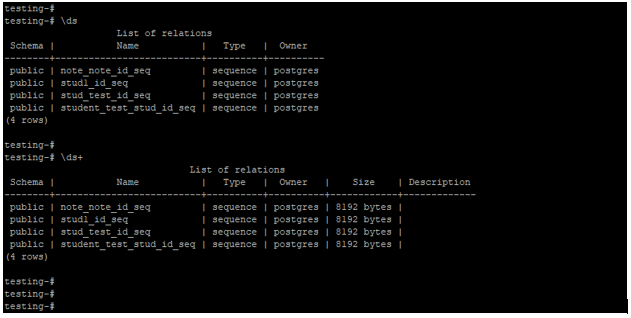

Its changes are auto-committed(all changes are automatically permanently saved in the database). Data Definition Language(DDL): It changes a table’s structure by adding, deleting and altering its contents. The above image broadly shows the different types of SQL commands available in SQL in the form of a chart.ġ. SQL Commands are instructions that are used by the user to communicate with the database, to perform specific tasks, functions and queries of data. Stores values of years as a 4digit number format, with a range lying between -1901 to 2155. It stores values relative to the Unix Epoch, basically a Unix Timestamp. Stores a combination of date and time in YYYY-MM-DD and hh:mm:ss format, with values in the range of ‘ 00:00:00’ to ‘ 23:59:59’. Stores time in hh:mm:ss format with times in the range of ‘-838:59:59’ to ‘838:59:59’. Stores date in YYYY-MM-DD format with dates in the range of ‘’ to ‘’. The below table lists all the Date/Time variables in SQL along with their description: Datatype The datatypes available in SQL to handle Date/Time operations effectively are called the Date/Time datatypes. If the precision parameter is set between 0 to 24, the type is FLOAT() else if it lies between 25 to 53, the datatype is DOUBLE().ĭecimal number with a number of digits before decimal place set by size parameter, and a number of digits after the decimal point set by d parameter. Integer with values in the signed range of 9223372036854775808 to 9223372036854775807 and values in the unsigned range of 0 to 18446744073709551615.īoolean values where 0 is considered as FALSE and non-zero values are considered TRUE. Integer with values in the signed range of -8388608 to 8388607 and values in the unsigned range of 0 to 16777215. Integer with values in the signed range of -32768 to 32767 and values in the unsigned range of 0 to 65535. Integer with values in the signed range of -128 to 127 and values in the unsigned range of 0 to 255. Integer with values in the signed range of -2147483648 to 2147483647 and values in the unsigned range of 0 to 4294967295. The table below lists all the Numeric Datatypes in SQL along with their descriptions: Datatypeīit-value type, where size varies from 1 to 64. String object with 0 or more values, chosen from a list of possible values with a maximum limit of 64 values. If no value is inserted, a blank value is inserted. String object that can have only 1 possible value from a list of size at most 65536 values in an ENUM list. It is used for Binary Large Objects and has a maximum size of 255bytes. Similar to VARCHAR() but stores binary byte strings. Similar to CHAR() but stores binary byte strings. Similar to CHAR.Ĭan contain a string of size up to 65536 bytes.Ĭan contain a string of up to 255 characters.Ĭan contain a string of up to 16777215 characters.Ĭan contain a string of up to 4294967295 characters. Variable-length string where the length may vary from 0-65535. The table below lists all the String type datatypes available in SQL, along with their descriptions: DatatypeĪ fixed-length string containing numbers, letters or special characters. The next section describes various most popular SQL server datatypes categorised under each major division. The above image is a chart that shows all the datatypes available in SQL along with some of their examples.

To allow the users to work with tables effectively, SQL provides us with various datatypes each of which can be useful based on the type of data we handle. Create or Alter or Delete some tables in a Database.The following functionalities can be performed on a database using SQL: Using SQL, we can create our own databases and then add data into these databases in the form of tables. SQL allows us to interact with the databases and bring out/manipulate data within them. It is used for storing, manipulating and retrieving data out of a database.

SQL or Structured Query Language is basically the language that we (the user) use to communicate with the Databases and get our required interpretation of data out of it. A Relational Database Management System is a collection of tools that allows the users to manipulate, organize and visualize the contents of a database while following some standard rules that facilitate fast response between the database and the user side.Īfter getting introduced to the concept of data, databases and DBMS/RDBMS, we can finally learn about SQL. A Database is a collection of small units of data arranged in a systematic manner. To get introduced to SQL, we first need to know about Databases and Database Management Systems(DBMS).ĭata is basically a collection of facts related to some object.


 0 kommentar(er)
0 kommentar(er)
